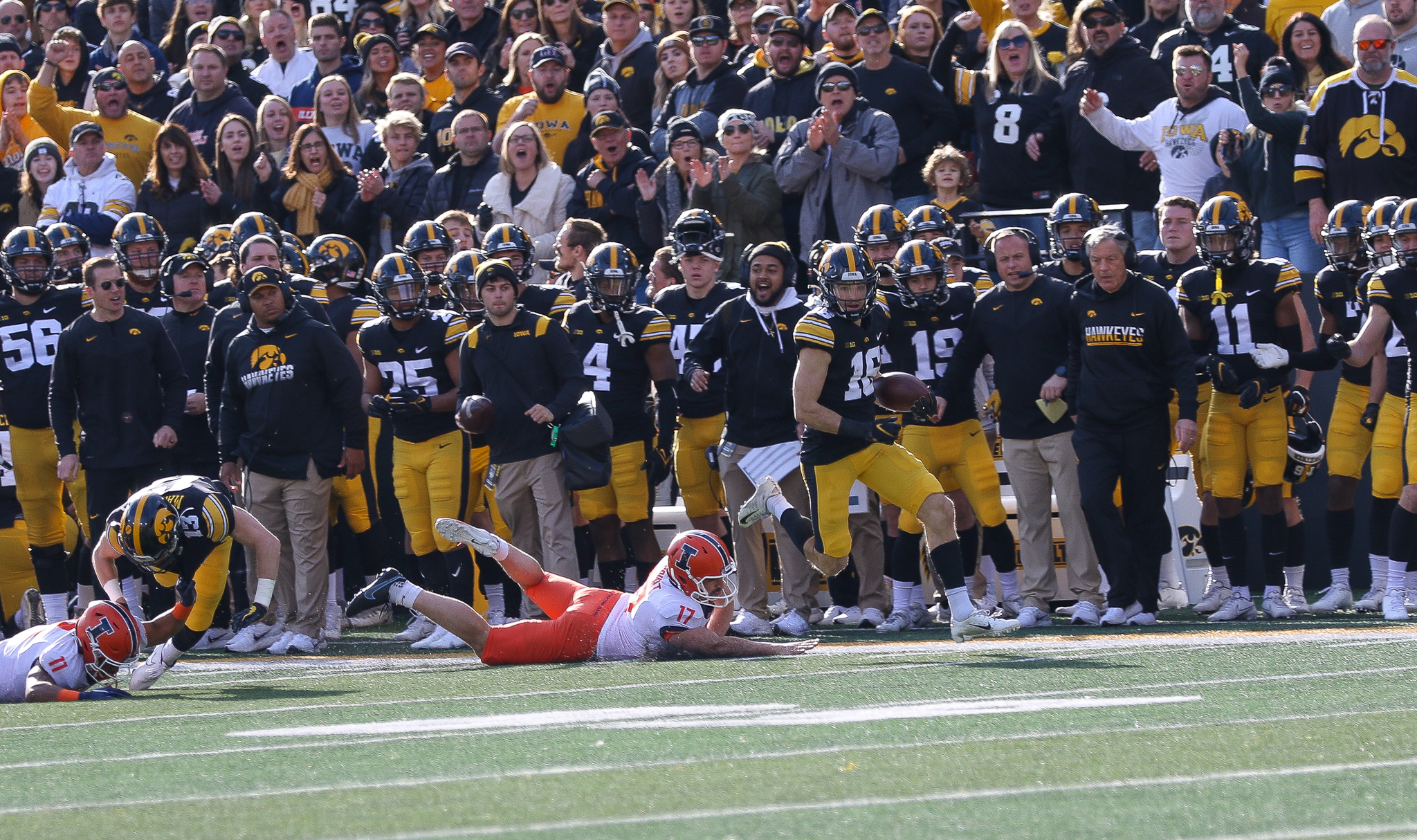Iowa vs. Nebraska and which team has the edge at nine different positions
By Pat Harty
IOWA CITY, Iowa – Nebraska is proof that it isn’t how many points a team scores that makes it successful.
And you could say the same about Iowa.
Nebraska (3-8) is ranked fourth in the Big Ten in scoring offense (28.5) and has outscored Iowa 314 to 280 heading into Friday’s annual showdown in Lincoln, Nebraska, but Iowa (9-2) still has six more victories.
All eight of Nebraska’s losses have been by nine or fewer points, including last Saturday’s 35-28 loss at Wisconsin.
The Cornhuskers will be without injured quarterback Adrian Martinez on Friday due to a shoulder injury, and to say that his loss is significant would be an understatement.
These teams look more even on paper than their records would indicate and that was apparent while trying to determine who has the edge at nine different positions.
Nebraska knows how to score points and make big plays on offense. It just hasn’t figured out how to win close games under fourth-year head coach Scott Frost.
Iowa struggles to score points and make big plays on offense, but has a knack for winning close games, thanks largely to its defense and special teams.
Here is a breakdown of which team has the edge at nine different positions:
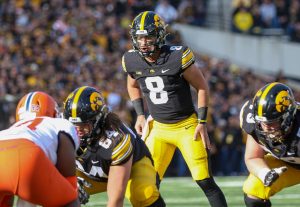
Quarterback: This was an easy choice before Adrian Martinez was ruled out of Friday’s game due to a shoulder injury, and it’s still an easy choice without him playing.
Nebraska would’ve clearly had the edge with a healthy Martinez running the offense, but without him, the advantage shifts to Iowa even though Alex Padilla will be making just his third career start, and his first on the road.
Compared to Nebraska redshirt freshman Logan Smothers, however, Padilla is a wily veteran.
Padilla is only completing 47 percent of his passes, and he threw for just 83 yards on 6-of-17 attempts in the 33-23 victory over Illinois last Saturday. But he also was hurt by at least five or six drops in the game.
Iowa also has a backup quarterback for Friday’s game with 17 starts under his belt, and a 12-game winning streak to his credit in junior Spencer Petras.
Smothers, on the other hand, has appeared briefly in five games this season and has 119 passing yards and 60 rushing yards. The Muscle Shoals, Alabama native is considered a good athlete and will test Iowa with his running ability.
But the loss of Martinez, who is Nebraska’s all-time leader with nearly 11,000 total yards, can’t be understated in terms of importance. He is the straw that stir’s Nebraska’s offense, and without him, it’s hard to give Nebraska much consideration for having an edge at quarterback.
Advantage: Iowa
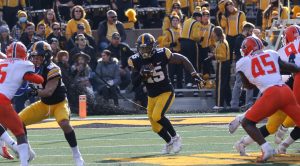
Running back: Nebraska averages about 70 more rushing yards per game than Iowa does, but that is due largely to Martinez, who leads the team with 525 rushing yards and with 13 touchdowns. Take away his 198 yards in losses and Martinez has rushed for over 700 yards.
Rahmir Johnson has been Nebraska’s most productive running back with 495 rushing yards and four touchdowns. However, that pales in comparison to what Nebraska’s running backs used to produce on a regular basis, and it’s barely half of what Iowa junior Tyler Goodson has gained on the ground this season.
Nebraska has also been hampered by injuries at this position.
Goodson leads Iowa with 945 rushing yards and six touchdowns, and is coming off a game against Illinois in which he gained 132 yards on 27 carries.
Redshirt freshman backup Gavin Williams is also starting to emerge as he showed against Illinois by rushing for 56 yards on 10 carries.
Advantage: Iowa
Receiver: Iowa doesn’t have a receiver with more than 328 receiving yards, while Nebraska has two, including Samori Toure, who has 831 receiving yards and five touchdowns on 40 catches.
Omar Manning is Nebraska’s second leading receiver with 340 yards on 25 catches.
True freshman Keagan Johnson, who is from the state of Nebraska, and the son of former Nebraska player Clester Johnson, leads Iowa with 328 receiving yards on just 16 catches. Johnson has seen his role on offense increase substantially in the second half of the regular season.
Another true freshman, Arland Bruce, also has seen his role increase as a slot receiver. Bruce has 18 catches for 169 yards and one touchdown, and 42 rushing yards and two touchdowns on jet sweeps.
Zavier Betts and Oliver Martin, yes that Oliver Martin, both provide depth for Nebraska when healthy. Martin, who played for Michigan and for Iowa before transferring to Nebraska, has 10 catches for 170 yards and one touchdown. The former Iowa City West standout missed four games earlier in the season due to injury.
Betts has 19 catches for 279 yards.
Iowa had at least five drops in the win over Illinois last Saturday, and most of them can be traced to the receiver position.
Advantage: Nebraska
Tight end: Junior Sam LaPorta leads Iowa in receiving yards (425) and catches (37) and is one of the most productive tight ends in the conference.
His presence alone often gives Iowa an advantage at this position, but this is one of the exceptions due to the season that Austin Allen is having for Nebraska. The 6-foot-9, 255-pound Allen has 36 catches for 547 yards and two touchdowns. He had 143 receiving yards in last Saturday’s 35-28 loss at Wisconsin.
Allen’s 36 catches are the most by a Nebraska tight end he needs just 14 yards to set the record for most yards in a season by a Nebraska tight end. Junior Miller has held the record of 560 receiving yards since 1978.
Travis Vokolek also gives Nebraska a quality backup at tight end, as does Luke Lachey for Iowa. Vokolek has 10 catches for 121 yards, while Lachey has four catches for 57 yards.
Both also excel as blockers.
Advantage: Nebraska
Offensive line: This is probably the toughest call amongst all the positions.
Iowa has by far the best offensive lineman overall in junior center Tyler Linderbaum, who is a finalist for the Outland Trophy, but the groups as a whole are pretty even in regard to experience and results.
Both units have young players in key roles and Nebraska also has a quality center in sophomore Cam Jurgens, who has started 17 straight games after having spent his true freshman season at tight end in 2019.
Linderbaum also switched positions, moving from defensive tackle to center during 2018 bowl preparation.
Again, this is a very close call, but Nebraska averages 185.91 rushing yards per game, while Iowa is 12th in the conference in rushing, averaging just 115.27 yards per game.
Advantage: Nebraska
Defensive line: This is another tough call as both units are pretty even.
Defensive end JoJo Domann leads the Nebraska defensive linemen with 72 tackles, while defensive end Zach VanValkenburg leads Iowa with 10 1/2 tackles for loss and eight quarterback hurries. Van Valkenburg also leads the Iowa defensive linemen with 43 tackles.
Iowa has seven defensive linemen with at least 14 tackles, while Nebraska has five defensive linemen with at least 22 tackles.
Iowa has 51 tackles for loss and 22 sacks as a team, while Nebraska has 54 tackles for loss and 18 sacks as a team.
Iowa senior Joe Evans has six sacks, six tackles for loss and six quarterback hurries despite only playing part time.
Defensive tackle Logan Lee also has come on strong for Iowa and is second amongst the Hawkeye defensive linemen with 38 tackles.
Advantage: Iowa
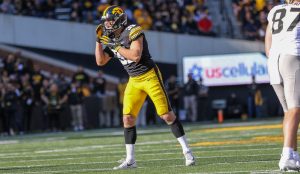
Linebacker: This is closer than you might think with junior Jack Campbell playing at an All-Big Ten level for Iowa. The Cedar Falls native leads Iowa with 108 tackles, and his sidekick at linebacker, junior Seth Benson, also has performed well with 79 tackles.
Throw in sophomore Jestin Jacobs and Iowa has three linebackers who have performed at a high level this season. Jacobs is fourth on the team with 46 tackles and he also forced a fumble against Iowa State that Campbell returned for a touchdowns.
Jacobs’s stat line is even more impressive when you consider that he only plays part-time since Iowa often uses five defensive backs and two linebackers.
As for the Cornhuskers, their linebackers also have led the way on defense. Luke Reimer and Nick Henrich are ranked first and second on the team with 101 and 91 tackles, respectively, while Garrett Nelson leads the team with 10 1/2 tackles for loss and five sacks. Reimer also has five tackles for loss and five pass breakups.
From a statistical standpoint, you could argue that Nebraska has the edge.
But the Iowa defense is better overall, and Iowa also has won six more games than Nebraska.
Advantage: Iowa
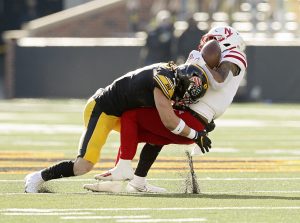
Secondary: Iowa leads the country in interceptions (21) and ranks fourth nationally in takeaways (26) mostly because of these guys. The loss of senior cornerback Matt Hankins to injury is significant, but sophomore Jermari Harris has started three games at cornerback and held his own.
Senior cornerback Riley Moss is also healthy after having missed three games due to a knee injury, and his presence should help to compensate for the loss of Hankins. Moss is second on the team with four interceptions.
Junior safety Dane Belton is tied for the NCAA lead with five interceptions, and he also excels against the run in Iowa’s 4-2-5 alignment, which puts him at linebacker.
Senior free safety Jack Koerner is expected to play in Friday’s game after having missed the Illinois game due to an injury.
Senior Deontai Williams leads an experienced Nebraska secondary with four interceptions, but he has missed the last three games due to an injury.
Senior Marquel Dismuke has started 31 consecutive games at safety for Nebraska, while junior Cam Taylor-Britt has started every game at cornerback this season, and he made second-team All-Big Ten last season.
Both units are loaded with veteran players, but Nebraska only has one defensive back with more than one interception, and that’s Williams, who has been injured.
Advantage: Iowa
Special teams: Iowa has the advantage at kicker, punter and in the return game.
Caleb Shudak has made 18-of-21 field-goal attempts for Iowa, while Connor Culp and Chase Contreraz have combined to make just 8-of-16 attempts for the Cornhuskers.
Iowa sophomore Tory Taylor is averaging 45.81 yards on 67 punts, and has placed 32 of his punts inside the opponent’s 20-yare line, while William Przystup is averaging 43.8 yards on 29 punts for the Cornhuskers.
Senior Charlie Jones gives Iowa a huge advantage in the return game. He is averaging 26.36 yards on 22 kick returns, and he returned a kick 100 yards for a touchdown against Illinois last Saturday when Iowa was trailing 10-0 late in the first quarter.
Jones is also averaging 8.76 yards on 33 punt returns.
Advantage: Iowa
